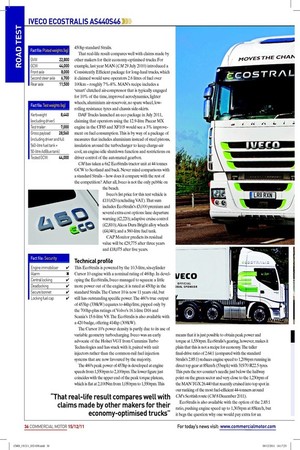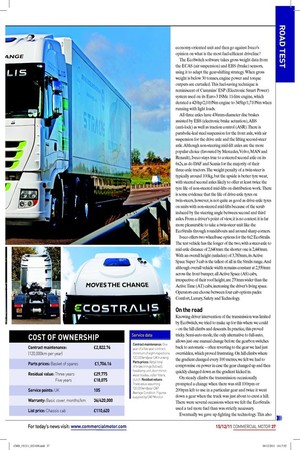Iveco launched EcoStralis in the UK in February this year,
Page 28

Page 30

Page 31

Page 32

If you've noticed an error in this article please click here to report it so we can fix it.
claiming that it would guarantee maximum productivity and minimise running costs (CM 3 February 2011). Compared with a standard Stralis, the EcoStralis includes a revised Euro-5/EEV engine, modiied automated transmission, a tall inal-drive ratio, Michelin’s X Energy Savergreen low-rolling resistance tyres and an air-kit as standard, plus several driver aids and management services such as telematics.
A new feature, called EcoSwitch, curbs the worst excesses of an errant truck driver by disconnecting kickdown and activating several load sensors that modify gear changing and reduce power and torque when the truck is below 30 tonnes GCW. It also limits maximum speed to 85km/h. Control of the EuroTronic (ZF ASTronic) automated transmission is different on the EcoStralis, with only minimal driver-induced changes permitted on hill climbs and descents. EcoSwitch is activated by the operator and is out of bounds to the driver.
Driver aids include ESP stability control and hill holder as standard, with lane departure warning, adaptive cruise control and tyre-pressure monitoring on the option list. Iveco’s Blue & Me Fleet telematics is standard. These extras make the EcoStralis, which comes with a three-year warranty, around £3,000 more expensive than an equivalent standard Stralis.
Before launching EcoStralis at the Hannover show last year, Iveco commissioned German testing organisation TOV SOD to conduct back-to-back testing of a 460hp 4x2 EcoStralis with a standard 450hp Stralis. EcoStralis delivered fuel savings of between 4.8% and 7.3%, depending on the type of running. EcoStralis’s features are designed to deliver most beneit in long-haul operations with high average speeds. Iveco followed that up with its own UK test on the track at Millbrook Proving Ground and over CM’s Scottish test route (CM 1 December 2011). The latter test – conducted by Iveco – found that a 460hp EcoStralis used 8.24% less fuel than a
450hp standard Stralis.
That real-life result compares well with claims made by other makers for their economy-optimised trucks. For example, last year MAN (CM 29 July 2010) introduced a Consistently Eficient package for long-haul trucks, which it claimed would save operators 2.6 litres of fuel over 100km – roughly 7%-8%. MAN’s recipe includes a ‘smart’ clutched air-compressor that is typically engaged for 10% of the time, improved aerodynamics, lighter wheels, aluminium air-reservoir, no spare wheel, lowrolling resistance tyres and chassis side-skirts.
DAF Trucks launched an eco package in July 2011, claiming that operators using the 12.9-litre Paccar MX engine in the CF85 and XF105 would see a 3% improvement on fuel consumption. This is by way of a package of measures that includes aluminium instead of steel pistons, insulation around the turbocharger to keep charge-air cool, an engine-idle shutdown function and restrictions on driver control of the automated gearbox.
CM has taken a 6x2 EcoStralis tractor unit at 44 tonnes GCW to Scotland and back. Never mind comparisons with a standard Stralis – how does it compare with the rest of the competition? After all, Iveco is not the only pebble on the beach.
Iveco’s list price for this test vehicle is £110,620 (excluding VAT). That sum includes EcoStralis’s £3,000 premium and several extra-cost options: lane departure warning (£2,220); adaptive cruise control (£2,810); Alcoa Dura Bright alloy wheels (£4,040); and a 560-litre fuel tank.
CAP Monitor predicts its residual value will be £29,775 after three years and £18,075 after ive years.
Technical profile
This EcoStralis is powered by the 10.3-litre, six-cylinder Cursor 10 engine with a nominal rating of 460hp. In developing the EcoStralis, Iveco managed to squeeze a little more power out of the engine; it is rated at 450hp in the standard Stralis. The Cursor 10 is now 11 years old, but still has outstanding speciic power. The 460’s true output of 453hp (338kW) equates to 44hp/litre, pipped only by the 700hp-plus ratings of Volvo’s 16.1-litre D16 and Scania’s 15.6-litre V8. The EcoStralis is also available with a 420 badge, offering 414hp (309kW).
The Cursor 10’s power density is partly due to its use of variable geometry turbocharging. Iveco was an early advocate of the Holset VGT from Cummins Turbo Technologies and has stuck with it, paired with unit injectors rather than the common-rail fuel injection systems that are now favoured by the majority.
The 460’s peak power of 453hp is developed at engine speeds from 1,550rpm to 2,100rpm. The lower igure just coincides with the upper end of the peak torque plateau, which is lat at 2,100Nm from 1,050rpm to 1,550rpm. This
means that it is just possible to obtain peak power and torque at 1,550rpm. EcoStralis’s gearing, however, makes it plain that this is not a recipe for economy. The taller inal-drive ratio of 2.64:1 (compared with the standard Stralis’s 2.85:1) reduces engine speed to 1,209rpm running in direct top gear at 85km/h (53mph) with 315/70 R22.5 tyres. This puts the rev counter’s needle just below the halfway point on the green sector and very close to the 1,230rpm of the MAN TGX 26.440 that recently cruised into top spot in our ranking of the most fuel-eficient 44-tonners around CM’s Scottish route (CM 8 December 2011).
EcoStralis is also available with the option of the 2.85:1 ratio, pushing engine speed up to 1,303rpm at 85km/h, but it begs the question why one would pay extra for an economy-oriented unit and then go against Iveco’s opinion on what is the most fuel-eficient driveline?
The EcoSwitch software takes gross weight data from the ECAS (air suspension) and EBS (brake) sensors, using it to adapt the gear-shifting strategy. When gross weight is below 30 tonnes, engine power and torque outputs are curtailed. This fuel-saving technique is reminiscent of Cummins’ ESP (Electronic Smart Power) system used on its Euro-3 ISMe 11-litre engine, which derated a 420hp/2,010Nm engine to 345hp/1,710Nm when running with light loads.
All three axles have 436mm-diameter disc brakes assisted by EBS (electronic brake actuation), ABS (anti-lock) as well as traction control (ASR). There is parabolic-leaf steel suspension for the front axle, with air suspension for the drive axle and the lifting second-steer axle. Although non-steering mid-lift axles are the more popular choice (favoured by Mercedes, Volvo, MAN and Renault), Iveco stays true to a steered second axle on its 6x2s, as do DAF and Scania for the majority of their three-axle tractors. The weight penalty of a twin-steer is typically around 100kg, but the upside is better tyre wear, with steered second axles likely to offer at least twice the tyre life of non-steered mid-lifts on distribution work. There is some evidence that the life of drive-axle tyres on twin-steers, however, is not quite as good as drive-axle tyres on units with non-steered mid-lifts because of the scrub induced by the steering angle between second and third axles. From a driver’s point of view, it is no contest: it is far more pleasurable to take a twin-steer unit like the EcoStralis through roundabouts and around sharp corners.
Iveco offers two wheelbase options for the 6x2 EcoStralis. The test vehicle has the longer of the two, with a steer-axle to mid-axle distance of 2,640mm: the shorter one is 2,440mm. With an overall height (unladen) of 3,783mm, its Active Space Super 3 cab is the tallest of all in the Stralis range. And although overall vehicle width remains constant at 2,550mm across the front bumper, all Active Space (AS) cabs, irrespective of their roof height, are 270mm wider than the Active Time (AT) cabs, increasing the driver’s living space. Operators can choose between four cab options packs: Comfort, Luxury, Safety and Technology.
On the road
Knowing driver intervention of the transmission was limited by EcoSwitch, we tried to make up for this where we could – on the hill climbs and descents. In practice, this proved tricky. Semi-auto mode, the only alternative to full-auto, allows just one manual change before the gearbox switches back to automatic – often reverting to the gear we had just overridden, which proved frustrating. On hill climbs where the gradient changed every 100 metres, we felt we had to compromise on power in case the gear changed up and then quickly changed down as the gradient kicked in.
On steady climbs the transmission occasionally prompted a change when there was still 100rpm or 200rpm left to use in a particular gear and twice it went down a gear when the truck was just about to crest a hill. There were several occasions when we felt the EcoStralis used a tad more fuel than was strictly necessary.
Eventually we gave up ighting the technology. This also had something to do with the rather inconvenient location of the gearbox manual override controls, three switches on the dashboard above the park brake. To be fair, when left to its own devices the transmission never made any truly poor decisions. Downward shifts under pressure occur at around 1,200rpm and are swift. On lat roads at a steady 64km/h (40mph) the gearbox allows the engine to lug down to 1,000rpm, just off the bottom end of the torque plateau.
On the motorway EcoSwitch’s 85km/h setting for the speed limiter was wasted on CM because that is our own limit anyway. While things were happy enough on lat motorways, when the road rose we noticed that the gearbox is programmed to make downshifts sooner than we expected. Under those conditions the EcoStralis seems inclined to stray towards that 1,550rpm mark where peak torque and power are briely together, rather than lugging down to exploit the torque plateau at lower engine speeds. Perhaps therein lies the answer to why Iveco offers the 2.85:1 inal drive ratio as an alternative in the EcoStralis: a little more engine speed might be appropriate in hillier terrain.
Productivity
During our test the EcoStralis delivered 8.36mpg, only 3% better than the Stralis AT450 with a Cursor 10 450hp engine and narrower Active Time cab that we tested in 2009 (see fuel results box). That is mildly disappointing and at odds with Iveco’s result, which produced a far greater margin of advantage for the EcoStralis. It must be pointed out that Iveco ran its back-to-back test with the two vehicles just a few minutes apart: two years separated ours.
Setting aside comparisons between Eco and nonEco, the EcoStralis nevertheless turned in very respectable fuel economy. Its overall igure of 8.36mpg is good enough to take it to second place in our fuel results table, well behind the MAN TGX 26.440 with its outstanding 9.27mpg (and no AdBlue), but just ahead of the Mercedes-Benz Actros 2546 that managed 8.14mpg and 5% AdBlue consumption. The EcoStralis consumed AdBlue at the rate of 4.9% of its fuel consumption.
In terms of kerb weight, EcoStralis compares poorly, weighing 8,440kg (excluding driver) as tested, despite alloy wheels slicing 185kg off its kerb weight. That leaves it 338kg heavier than the TGX. Almost 100kg of that is due to carrying 560 litres of fuel rather than the MAN’s 450 litres. Fifty litres of AdBlue and the associated tank and SCR system, all absent from the MAN, probably account for about another 70kg of the EcoStralis’s surplus. Then there is the 100kg or so relating to the use of a steered rather than non-steered second axle.
At an average speed of 71.4km/h, EcoStralis was substantially quicker round the test route than the Stralis AT450, which averaged 68.6km/h two years ago. But it was 1.6km/h slower than the Actros and 2.7km/h slower than the TGX. ■



















































